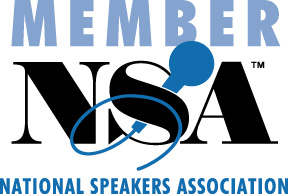Neuro-Linguistic Programming and the Unconscious Mind:
Keys to NLP's Effectiveness
Right Brain, Left Brain Distinctions
One of the first major findings of modern brain research is that each hemisphere of the brain provides a distinct function.
In general the left side manages functions that are linear, logical, and analytic in nature. This hemisphere also contains the brain's language center. Thus, most of what we call "reasoning" is done on the left side of the brain.
The right brain is the domain of what we typically think of as our "creative side." What the right brain contributes is the ability to make intuitive leaps, to synthesize broad bodies of information, and to recognize patterns. For instance, our ability to put names with faces is a pattern-recognition function of the right-brain. Our ability to recognize a tune is another one.
The two brains also share some duties. For instance, motor skills on the right side of the body are controlled by the left hemisphere, while the right hemisphere controls motor functions on the left. The left brain also processes the right field of vision (not the right eye, but the right half of the vision field), with the right brain processes the left field of vision.
Recent research has begun to soften the line of demarcation that distinguishes left brain activity from right brain activity. We now know that those distinctions were once too rigidly made. But the distinctions above continue to serve as helpful generalizations.
Of the two hemispheres, one will tend to take the lead while the other serves as a collaborator. Thus, we speak of left-brain and right-brain dominance. Highly analytical people tend to be left-brain dominant, while people with exceptional powers of intuition are often right-brain dominant.
The Conscious and Unconscious Minds
We also find it helpful to distinguish between the conscious mind and the unconscious mind. When we have immediate awareness of something, we refer to it as being a conscious mind activity. When it is somewhat removed from immediate awareness, we refer to it as unconscious mind activity.
The vast majority of our mental processing is at the unconscious level. With the exception of a few rare individuals, the conscious mind has an upper limit of about nine streams of information that it can track simultaneously. For most of us the limit is somewhere between five and seven. We therefore speak of the conscious mind being able to process 7± 2 information streams at a time.
The unconscious mind, on the other hand, tracks millions of bits of data every second, and does so effortlessly. One thing it does is to pass information to or withhold information from the conscious mind. In other words, the conscious mind has access to unconscious mind activity only if the unconscious mind grants it that permission.
One goal of neurolinguistic programming (NLP) is to bring about a full collaboration between the conscious mind and the unconscious mind so that they work together rather than stage a turf war.
Conscious Mind Specialization
The conscious mind is the digital side of thinking, meaning that the conscious mind subjects every thing it processes to a logic test. Is this statement true? Or is it false? Is what I'm experiencing logical? Or is it irrational? The conscious mind is logic-driven.
As we have said, the conscious mind is also the realm of immediate awareness. Or to put it another way, if the conscious mind is oblivious to a stimulus or input, it is as though that sitmulus or input does not exist.
In addition, the conscious mind is the locus for reflective review of what we experience (or have experienced). Here we explore our options and make deliberative choices about how we will respond to emotional and sensory experience.
Unconscious Mind Specialization
The unconscious mind, by contrast, makes no logical, moral, or ethical judgments about the objects of its thought themselves. It leaves that role to the conscious mind. In this regard the unconscious mind is largely uncritical of throughput from the conscious mind.
When repeatedly told by the conscious mind that a certain thing is true, the unconscious mind will start to act accordingly. It will muster its resources to align with the judgments of the conscious mind. If the conscious mind regularly says that all black dogs are dangerous, the unconscious mind will obligingly provide a fear response that fires off automatically whenever a black dog comes into view.
In effect, the unconscious mind "frees up" the conscious mind to specialize as a discriminator. The unconscious mind takes care of the "clutter" that would otherwise impede quick judgments and the exercise of discretion. To view this another way, the unconscious mind manages all those things that do not need conscious awareness.
Thus, while the conscious mind is busy reflecting on what is happening, the unconscious mind is quietly regulating body temperature, breathing rhythms, heartbeats, and the myriad of other physiological functions essential to survival. It is also alertly monitoring and responding to external events that must be tended to, even though they may not call for conscious attention at the moment.
For instance, if you are taking notes during a phone conversation with someone who is upset, all your conscious energies may be concentrated on what the other party is saying and how to frame your reply. Meanwhile, you are jotting down notes almost automatically, because the unconscious mind is translating ideas into notations on the page without you consciously thinking about the process.
Just because we are inattentive to what the unconscious mind is doing, howerver, does not mean that its activities are of subordinate importance. At any given moment the unconscious mind is regulating more of our physiology than is the conscious mind. As a result, the unconcious mind is a primary determinant of behavior. Neurolinguistic programming (NLP) uses these external behavioral clues to see beyond conscious mind activity to the processes running at the unconscious level.
One Reason For NLP's Success
Because the conscious mind typically gives itself to tasks of logic and analysis, it ties itself closely to left brain activity. This is not to equate the left brain and the conscious mind, as though they were one. We are merely saying that the left brain and the conscious mind share a common bias and therefore cooperate closely. The unconscious mind, on the other hand, affiliates itself with the rich symbol processing of the right brain.
Since most people are left brain dominant, communicating with the unconscious mind frequently entails getting the left brain to "step aside" to allow us direct dialogue with the right brain.
One reason that NLP is so successful is that it has developed techniques that by-pass the conscious mind to work directly with the unconscious mind, which controls most of our behavior. Therefore, the conscious mind does not have an opportunity to "editorialize" on the throughput and distort it or reject it.
© 1998, Michael C. Armour, Ph.D.





